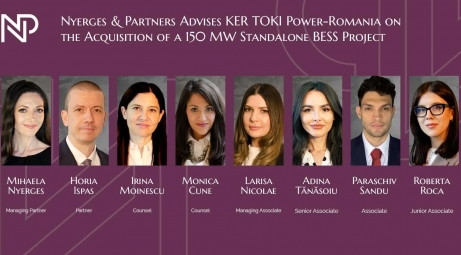
Article written by Mihaela Nyerges, Managing Partner and Diana Dulamă, Associate at Nyerges & Partners.
On February 1, 2024, the Romanian Energy Regulatory Authority (“ANRE”) published for public consultations a draft of order amending the main grid connection regulations (the “Draft”). The public consultations will be conducted for a period of 30 days.
The Draft brings important changes to existing grid connection rules, some of which are envisaged to be enforced immediately, while other more fundamental changes are planned to be enforced at the beginning of next year.
1.NEW RULES FOR FINANCIAL GUARANTEE
According to existing rules, developers of new projects must establish a financial guarantee in favour of the grid operator (i) only if the connection is conditional upon grid reinforcement works and (ii) within maximum 12 months from the issuance of the grid connection permit (“ATR”). The value of the guarantee is determined on a case-by-case basis by the grid operator depending on the amount of reinforcement works needed, being capped at 20% of the connection tariff.
ANRE intends to change the guarantee mechanism as follows:
- Extended applicability: the financial guarantee should apply to all new projects, irrespective of whether reinforcement works are required or not; it does not apply to projects already having ATRs;
- ATR precondition: the financial guarantee is due before the issuance of the ATR;
- Fixed value: the financial guarantee amounts to 5% of the connection tariff;
- Enforcement rules: the cases entitling the grid operator to enforce the guarantee are not being changed, being, essentially, if the investor (i) fails to file the application for signing the connection agreement, (ii) fails to pay the connection tariff by the connection agreement deadlines or (iii) fails to complete the project by the connection agreement deadline;
- Restitution cases: the cases when the guarantee is returned to the investors are slightly clarified, being essentially when the project is commissioned, and the necessary grid reinforcement works are completed.
By extending the guarantee applicability to all projects and imposing it as a condition for ATR issuance, the Draft positively responds to market requests of a mechanism that would limit the artificial blockage of the grid by new ATRs issued for unfeasible projects or projects lacking financing sources.
In addition, the unique percentage for its value eliminates the concerns expressed on the market of unfairness of the current system in which the grid operator determines the percentage on a case by case basis.
From a different perspective, establishing the guarantee at a time when the project feasibility is still uncertain, combined with the enforcement thereof if the connection agreement is not signed or project not finalized (irrespective of the reason) may increase the investment risks. This applies, for example, if the connection depends on reinforcement works not included in the investment plans of grid operators, in which case, at ATR stage, investor may not have a complete and accurate view of (i) the commissioning date of the reinforcement works or of (ii) the exact reinforcement costs that will be due for ensuring the connection of its project (since the reinforcement tariff set out in the ATR (Ti) represents only part of the total reinforcement works value).
2.REDO OF GRID CALCULATIONS
According to current rules, if a project files for on-grid testing before the completion of the reinforcement works set out in the ATR, the grid operator must redo the grid capacity calculations for the respective project by taking into consideration only (i) operational projects and (ii) projects having filed the on-grid testing application.
Investors planning to advance fast with their projects rely on this mechanism and on the fact that no reinforcement works will be needed based on the new calculation. Nevertheless, the current mechanism also raises uncertainties as to how this will impact the connection of those projects which do not have grid reinforcement works in the ATR, but are being developed at a slower pace.
Potentially to address the above uncertainties, the Draft provides that, when redoing the grid calculations, the operator will also take into consideration all valid ATRs, irrespective of the implementation status of the respective projects. Although such change has, in principle, a positive impact, the ATRs considered in the calculation should be only those which were initially considered in the solution study elaborated for the respective project. Otherwise, the priority principle will be disturbed.
3.OWNERSHIP OVER THE NEW CONNECTION INSTALLATIONS
Unlike the first wave of renewables (when the connection installations financed by investors through the connection tariff were owned by grid operators), currently, the connection installations are owned by those which finance it – namely by investors. This principle applies irrespective of whether the project is connected to the distribution or transmission grid.
There have been concerns that the above principle violates the provisions of the Energy and Gas Law no. 123/2022 which state that the grid having a voltage above 110 kV is part of transmission grid, which is the monopole of the TSO.
Due to the above, the Draft provides that, in case the connection is envisaged to grid having a voltage higher than 110 kV, the new connection substation and line are part of the transmission grid and qualify as reinforcement works. As result of such qualification, although not expressly mentioned, we estimate that the investors will no longer have the option to conclude directly the agreement for the design/execution of the respective connection installations, but will only have the right to designate the designer/contractor.
The Draft also contains a rather interpretable provision that the new connection substations are transferred to grid operators for “just compensation”, which seems to be applicable irrespective of the voltage/grid to which the connection is envisaged. We hope such will be clarified during the public consultation process.
The above principles are meant to be applicable only to projects for which the ATRs have not yet been issued.
4.GRID CAPACITY ALLOCATION BASED ON AUCTION
ANRE envisages to fundamentally change the grid connection process applicable to projects of at least 1 MW by allocating the capacity based on auction. The mechanism is intended to be implemented starting January 2025.
While only general principles are set out in the Draft, detailed application rules are envisaged to be elaborated by OTS within 60 days from the adoption of the Draft.
- Auction timeline: The auctions are organized on a yearly basis (Year Y), for a 10-year allocation period starting with the second year after the auction (Year Y+2);
- Process:
- By January 15 of Year Y, TSO determines and publishes the available capacity for each zone of the transmission/distribution grid for which no grid reinforcement is needed for Year Y+2;
- By end of February of Year Y, investors file application for capacity allocation in a specific grid zone and year of the allocation period (i.e. the year when the project is expected to be commissioned);
- By March 15 of Year Y, TSO registers, in a dedicated online platform, all complete applications filed by investors for each grid zone and each year of the allocation period;
- By June 15 of Year Y, TSO (i) performs a global solution study determining the necessary reinforcement works for all applications filed, the estimative value, duration and commissioning year and (ii) publishes for each grid zone/allocation year the results of the study, the available capacity with/ without reinforcement works, estimative value of reinforcement works, auction starting price and date;
- Starting July 1 of Year Y, TSO organizes daily auction sessions for allocating the available capacity in each year of the 10-year allocation period.
- Auction starting price: the auction starting price is determined by dividing the total estimative value of the reinforcement works plus the solution study value by the total MW capacity requested by investors;
- Participation guarantee: investors must set out a participation guarantee equal to 1% of the auction starting price, calculated based on the capacity auctioned by each investor;
- Allocation contract: the selected investors conclude a 3-party allocation contracts with TSO and DO observing the minimum terms regulated by ANRE;
- Price calculation: the price due by investors differs depending on the available capacity and total auctioned capacity, being essentially as follows:
- if the available capacity (without the need of reinforcement works) is higher than the total capacity auctioned by investors, all offers are accepted, and no price is due;
- if the available capacity (including that resulted from reinforcement works) is higher than the total capacity auctioned by investors, all offers are accepted and the auction starting price is due;
- if the available capacity (including tht resulting from reinforcement works) is lower than the one auctioned, investors pay the auctioned price;
- Price payment: 20% of the price must be paid within 30 days from the signing date, while the rest no later than 4 months from the signing date;
- Delay penalties: daily delay penalties of 0.01% of the price are due (i) by grid operator for delays in performing reinforcement works and (ii) by investors for delays in commissioning the projects.



 February 13, 2024 08:39
February 13, 2024 08:39 










